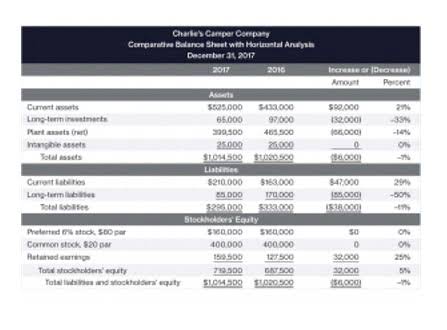The Basic Accounting Equation Financial Accounting
October 1, 2020 Mahmoud Hosny No Comment
Importantly, it also covers relevant etymologies and word histories in cases where knowledge of these elements can help you better understand the term. This resource introduces and explains basic accounting terms, principles, acronyms, and abbreviations. It was developed for students, entrepreneurs, and anyone else looking to brush up on essential concepts. So, let’s take a look at every element of the accounting equation.

Liabilities
The transaction would generate an ROI of 25% for the investor. When an investor incurs a loss, the ROI is expressed as a negative number. When retained earnings (RE) are positive, they increase the organization’s equity. That equity may then be reinvested back into the business to fuel its future growth.
- In essence, a business uses liabilities and shareholders’ equity to obtain sufficient funding for the assets its needs to operate.
- As business transactions take place, the values of the accounting elements change.
- Receivables arise when a company provides a service or sells a product to someone on credit.
- If a company’s stock is publicly traded, earnings per share must appear on the face of the income statement.
- Certified public accounting and management accounting are two of the profession’s most common specializations.
Best Online Bookkeeping Services of 2024
- For instance, imagine an investor who purchases $20,000 of a company’s stock, then sells the stock for $25,000.
- Every transaction is recorded twice so that the debit is balanced by a credit.
- Now that we have a basic understanding of the equation, let’s take a look at each accounting equation component starting with the assets.
- Debt is a liability, whether it is a long-term loan or a bill that is due to be paid.
- Businesses must account for overhead carefully, as it has a significant impact on price-point decisions regarding a company’s products and services.
This statement reflects profits and losses that are themselves determined by the calculations that make up the basic accounting equation. In other words, this equation allows businesses to determine revenue as well as prepare a statement of retained earnings. This then allows them to predict future profit trends and adjust business practices accordingly. Thus, the accounting equation is an essential step in determining company profitability. The accounting equation states that total assets is equal to total liabilities plus capital. This lesson presented the basic accounting equation and how it stays equal.
Financial Accounting
The balance sheet is also referred to as the Statement of Financial Position. The accounting equation plays a significant role as the foundation of the double-entry bookkeeping system. It is based on the idea that each transaction has an equal effect. It is used to transfer totals from books of prime entry into the nominal ledger.
If it’s financed through debt, it’ll show as a liability, but if it’s financed through issuing equity shares to investors, it’ll show in shareholders’ equity. Accounting ratios help you to decide on a particular position, investment period, or whether to avoid an investment altogether. Accounting ratios come with wide-reaching use and necessity, even for those of us who are not accountants. Many of us like to invest money that we look at as long- or short-term opportunities.

Some common partnerships include doctor’s offices, boutique investment banks, and small legal firms. Incorrect classification of an expense does not affect the accounting equation. To make the Accounting Equation topic even easier to understand, we created a collection of premium materials called AccountingCoach PRO.
- Accounting advances financial literacy and yields precise, powerful insights into financial health.
- This lesson presented the basic accounting equation and how it stays equal.
- Small businesses and individuals tend to use cash basis accounting.
- Types include current and noncurrent, operating and nonoperating, physical, and intangible.
Accounting Ratios: Taken in Context

They can better help you make decisions and understand the overall health and profitability of your division. The net income equation, then, shows you how profitable your business’ operations are, but not how healthy your cash flow is. Accountants also distinguish https://www.bookstime.com/articles/contra-expense between current and long-term liabilities. Current liabilities are liabilities due within one year of a financial statement’s date. Beyond basic accounting terms, this resource also explains alternative word uses and defines related or adjacent concepts.

Module 1: The Role of Accounting in Business
Your fixed costs are your normal, recurring, predictable expenses. If you need to create an income statement, you can do so with QuickBooks. Ideally, your current ratio should always be greater than 1. A current ratio that is too high, though, can indicate you aren’t managing your capital efficiently, and as a result your business growth could stagnate. This means your equity — the total of your combined contributions and profits you have not taken out of the business in the form of draws and distributions — is $10,000.
Post-Closing Trial Balance
Not only does the accounting equation underpin all accounting entries, but it also forms the exact structure of one of accounting’s most important reports – the balance sheet. Once you are done with these lessons be sure to check out the final lesson on the accounting equation and financial position, which will give you more info and certainty about this key concept. Metro Courier, Inc., accounting basic formula was organized as a corporation on January 1, the company issued shares (10,000 shares at $3 each) of common stock for $30,000 cash to Ron Chaney, his wife, and their son. The Accounting Equation is a vital formula to understand and consider when it comes to the financial health of your business. The accounting equation is a factor in almost every aspect of your business accounting.
Recent Posts
- The Method To Outsource Front-end Growth Efficiently
- “Internet Casinos Con Dinero Genuine En Argentina Top 2024
- Vodka Слоты – Рабочее зеркало сайта, интернет казино на деньги
- En Yüksek Değerli deneme bonus veren siteler Teklifleri
- Mostbet Seyrək 90 Azərbaycanda Bukmeker Və Casino Bonus 550+250fs</tg
Recent Comments
Archives
Categories
- ! Без рубрики
- 1
- 1win Brazil
- 1win India
- 1WIN Official In Russia
- 1win Turkiye
- 1win uzbekistan
- 1winRussia
- 1xbet AZ Casino
- 1XBET AZ Giriş
- 1xbet Casino AZ
- 1xbet Casino Online
- 22bet IT
- Artificial intelligence
- Artificial intelligence (AI)
- Bankobet
- Basaribet
- bizzo casino
- blog
- book of ra
- Bookkeeping
- casino
- casino en ligne fr
- casino online ar
- Cbet GG Cassino
- Cryptocurrency exchange
- Education
- FinTech
- IT Vacancies
- IT Образование
- Kasyno Online PL
- king johnnie
- Masalbet
- Mostbet AZ Casino
- mostbet azerbaijan
- Mostbet Casino AZ
- Mostbet Casino Online UZ
- Mostbet Russia
- Mostbet UZ
- Mostbet UZ Casino
- mostbet uz kirish
- News
- Pin Up AZ
- Pin UP AZ Online
- Pin UP CASINO AZ
- Pin UP Casino Online
- pinco
- slot
- Sober living
- Software development
- sugar rush
- Trading Bot
- Uncategorized
- Финтех
- Форекс Обучение
- Форекс партнерская программа